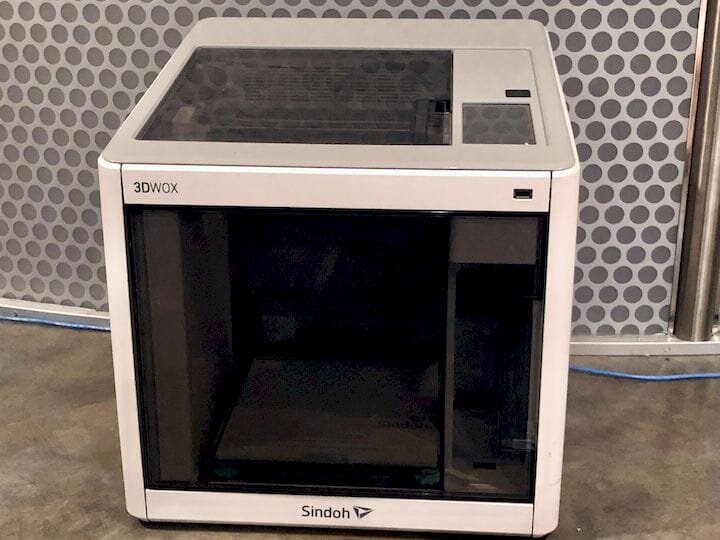![A possible consumer 3D printer? [Source: Fabbaloo]](https://fabbaloo.com/wp-content/uploads/2020/05/image-asset_img_5eb08e950128c.jpg) A possible consumer 3D printer? [Source: Fabbaloo]
A possible consumer 3D printer? [Source: Fabbaloo]
Here’s how to recognize a consumer 3D printer.
We’ve had several posts and discussions lately considering the notion of “what is a production or industrial 3D printer?” That’s a rather difficult question to answer as there are countless different situations to consider, but we gave it a try. Two tries, actually, one by myself, and one by Julie Reece.
There are other types of 3D printers, of course, and one of them is the elusive “consumer 3D printer”.
Consumer 3D Printers
Does such a thing really exist? What would its characteristics be?
For some years, the concept of a consumer 3D printer was foremost in the minds of entrepreneurs and investors, who foresaw a future world where every home would be equipped with a powerful 3D printer, able to produce arbitrary goods on demand. A revolution in consumer sales!
Unfortunately, they foresaw wrongly.
The consumer market never really developed, largely because of several key reasons:
-
The devices were too expensive
-
The devices were unreliable and required expertise and patience to operate beyond levels found among mainstream consumers
-
The devices required easy-to-use content that wasn’t available or appropriate
-
The devices required maintenance by skilled technicians frequently
-
The devices would benefit from operators skilled in CAD tools, which consumers were not
-
Finally, no “killer application” drew consumers to the devices
As a result, the expected boom in consumer 3D printer never happened. It never will — at least until the above barriers are clearly knocked down by someone.
In the meantime what we might call “consumer” 3D printers are really devices addressing the DIY crowd. This market segment is significant, but far smaller than the expected consumer market. In spite of the small market size, it has been large enough to support the evolution of many small to medium-sized 3D printer manufacturers specializing in the space.
What might the characteristics be for a consumer / DIY 3D printer? Here’s my thoughts:
Low-Cost 3D Printer
Above all, the cost of the device should be low. As low as possible, as DIY folks are among the most thrifty. I suspect that’s because they are able to make things for themselves at low cost, so the things they buy should also be low cost.
Open Materials
While some 3D printers insist on using proprietary material only, a consumer 3D printer should always allow use of any reasonable material in an “open materials” regime. This permits the consumer to use not only low-cost materials, but also the ability to experiment with unusual materials.
Low-Temperature Materials
Some professional 3D printers enable the use of high-temperature materials like PEEK, ULTEM and others. That’s not a feature you’d ever see in a consumer 3D printer where in general the applications would not require the use of exotic materials.
Reliable 3D Printing
One of the more important characteristics is that the machine should not break frequently and should produce reasonably good quality prints. While there are always plenty of crappy machines available, those that break a lot are quickly identified by the community, causing a rise in sales of those machines that do behave.
Maintainable 3D Printer
All 3D printers break and consumer 3D printers should be designed for their DIY operators to fairly easily perform repairs. This is not the case for some professional machines and certainly industrial production machines that would require a trained technician to provide service.
Basic Ease-of-Use Features
There is a list of ease-of-use features that you might expect to see in a consumer 3D printer, such as a color touchscreen, automated leveling, magnetic removable print surface, etc. This list is constantly enhanced as competition drives progress. But a device without the “usual” features would not be welcomed by consumers.
Support System
This is not a hardware feature, but something that should be provided by the manufacturer: a way to easily support the machine through an online community. From this platform operators can share issues, solutions and thoughts, making the machine’s ecosystem strong and attractive to new buyers.
3D Content
There should be ways for the consumer 3D printer operator to easily obtain 3D content for the device. While anyone can pillage the internet for pillage 3D models, a consumer 3D printer should have some method for more easily doing so.
Small to Medium Build Volume
Consumer 3D printers need not have extremely large build volumes. From 150-250 mm would be typical.
Upgradeability
Many DIY 3D printer operators would prefer to upgrade their 3D printer investment rather than replacing it with a new device. Thus the machine should be designed with some possibility of upgrades as the machine evolves into the future.
General 3D Printing Usage
Finally, the consumer 3D printer should not be specifically targeted by the manufacturer at any specific application. No one can know what applications a consumer might produce on such a device, and therefore it should be positioned as a general purpose 3D printer, in spite of its limitations in materials, size and quality.
I think that if you see a 3D printer with many of the above characteristics, you’d likely be looking at what could be called a “consumer 3D printer”.

